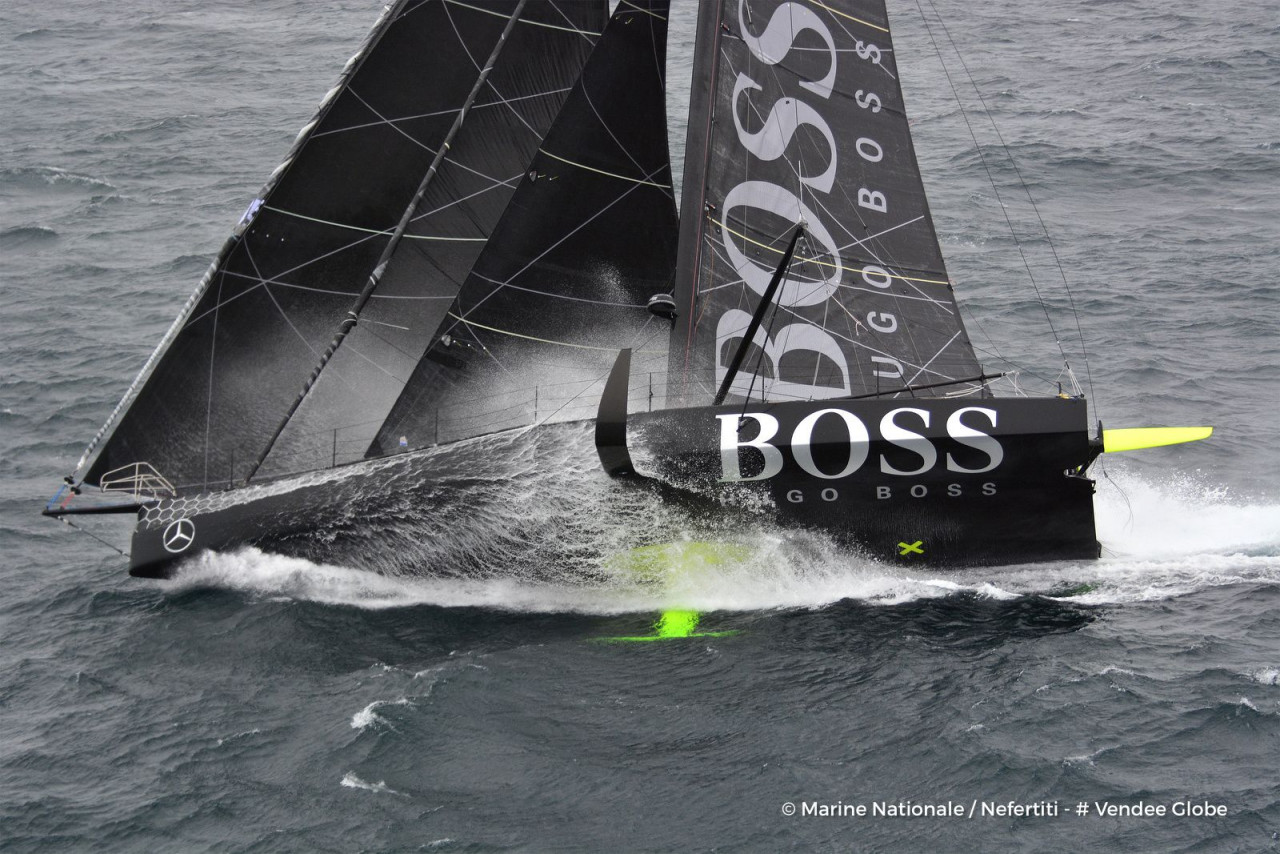A unique encounter offshore of the TAAF (French Southern and Antarctic Lands)

Unprecedented footage of the Vendée Globe frontrunners smashing through the Southern Ocean has been captured on camera for the first time in the solo round the world yacht race's 27-year history.
Unprecedented footage of the Vendée Globe frontrunners smashing through the Southern Ocean has been captured on camera for the first time in the solo round the world yacht race's 27-year history. The stunning images of French sailor Armel Le Cléac'h, Brit Alex Thomsonand French Sébastien Josse as they passed the Kerguelen Islands deep in the southern Indian Ocean were filmed by French television station TF1.
The Kerguelens are an archipelago of more than 300 islands that form one of the most remote places on the planet – Africa lies 2,000 miles to the west, Australia is 2,000 miles to the east and Antarctica is 1,000 miles to the south. It is the first time since the Vendée Globe began in 1989 that competitors have been filmed racing so far south. It was made possible thanks to the work of the French navy, TF1 and the Vendée Globe's race directors.
All three skippers are sailing cutting-edge 60ft raceboats fitted with special hydrofoils that help lift them partially out of the water to reduce drag and therefore increase speed. Thomson, 42, the only British skipper among a field of 29 starters, suffered damage to one of his two foils earlier in the race when it was broken off in a collision with an unknown object.
Speaking to race HQ this Wednesday 30th of November, Thomson said the arrival of the TV crew had been a welcome distraction from racing in such isolation. “I had about 25 – 30 knots, and the sea state was really horrible - very grey, bloody freezing, so it was a nice distraction for the helicopter to come,” Thomson said. “The pilot did a nice bit of backwards flying while he was doing some filming when I had the Union flag out, so I thought it was really cool actually, it was a really nice thing, and to whoever organised that I'd like to say thank you very much, much appreciated. The sails I had up were two reefs [in the mainsail], a staysail, and a fractional zero. I think I was averaging 21.5 knots, so top speed was possibly 28, and down as low as 17 probably. I was averaging about 21.5, something like that, so not too bad for a non-foiler. It was nice to see people in the helicopter, that was interesting. It was good to have some other people around.”
The Vendée Globe began in Les Sables d'Olonne, France, on November 6. Competitors race solo around the world via the Cape of Good Hope and Cape Horn before returning to Les Sables – a journey of around 25,000 miles. The leading pair are neck and neck after more than 10,000 miles of ocean racing. Thomson said he was relishing the battle with Le Cléac'h, but was also pleased to have him nearby should anything go wrong onboard.
In 2006 Thomson's life was saved by fellow Brit Mike Golding during a round the world race after the keel on his boat broke off in the Southern Ocean. “It's good to have Armel there as a pacemaker, someone to be able to measure yourself against,” Thomson said. “I think it makes us both faster. As well as that there's the safety, obviously. I was in a similar situation in 2006 with Mike Golding. My keel broke and by the time I needed to abandon the boat he was 100 miles down the track, and all credit to Mike he turned his boat around, put three reefs in and a foresail up and came back and saved my life.”
Sébastien Josse commented this Friday 2, November : « At daybreak this morning, I had the helicopter from the French Navy just 50 metres astern of me! It was rather nice as there's not a lot of entertainment in the vicinity, joked the skipper of Edmond de Rothschild. They stayed with me for around forty minutes or so and we talked about the race and the upcoming strategy It really was a great moment. I admire the quality of the guy piloting the helicopter as he was able to do exactly what he wanted with it. »
This operation is a major first in the history of the Vendée Globe and it took many months of organisation as well as the mutual support for the project of the French Navy, TF1 and the Vendée Globe. However, the results speak for themselves. These images are truly fascinating given the remote, hostile filming location as well as the fact that they lift the veil on one of the most mysterious elements of offshore racing: the reality of sailing singlehanded in the middle of the Indian Ocean. In that regard, they're naturally a great success in terms of communication, but it goes far deeper than that as they expand the imagination of hundreds of thousands of people who get a real kick out of following this solo, non-stop, unassisted round the world race on a daily basis.
Teams info
After a stunning 2025 season Sam Goodchild is the IMOCA Globe Series Champion for the second time
After a long season at the top of the IMOCA fleet that featured three race wins, Great Britain’s Sam Goodchild is for the second time in three years the IMOCA Globe Series Champion.
•••Quel rôle peut jouer la course au large dans la transformation du transport international ? Avec Pie…
Pour ce 10ᵉ épisode de Transitions, enregistré au Havre lors du départ de la Transat Café L'Or, nous recevons Jeremy Pochman, PDG de 11th Hour Racing, et Pierre-Antoine Morvan, responsable du pôle course au large et supe…
•••